MREGC5001: Asset Management, Design & Life Cycle Costs Assignment
VerifiedAdded on 2023/04/07
|12
|2260
|310
Report
AI Summary
This report discusses asset management and life cycle costing within a capital-intensive organization. It covers stakeholder expectations, maintenance organization scope, documented systems, leadership commitment to risk-based maintenance, and the use of life cycle costing in decision-making. The report identifies gaps in current practices compared to international standards and suggests improvements, including stricter documentation compliance, enhanced staff training, and thorough failure investigations. It also addresses the time value of money and availability measures like MTTR, MTBF, and MTTF, concluding with methods for measuring and improving maintainability within the organization. Desklib provides a platform to explore this document, offering study tools and resources for students.
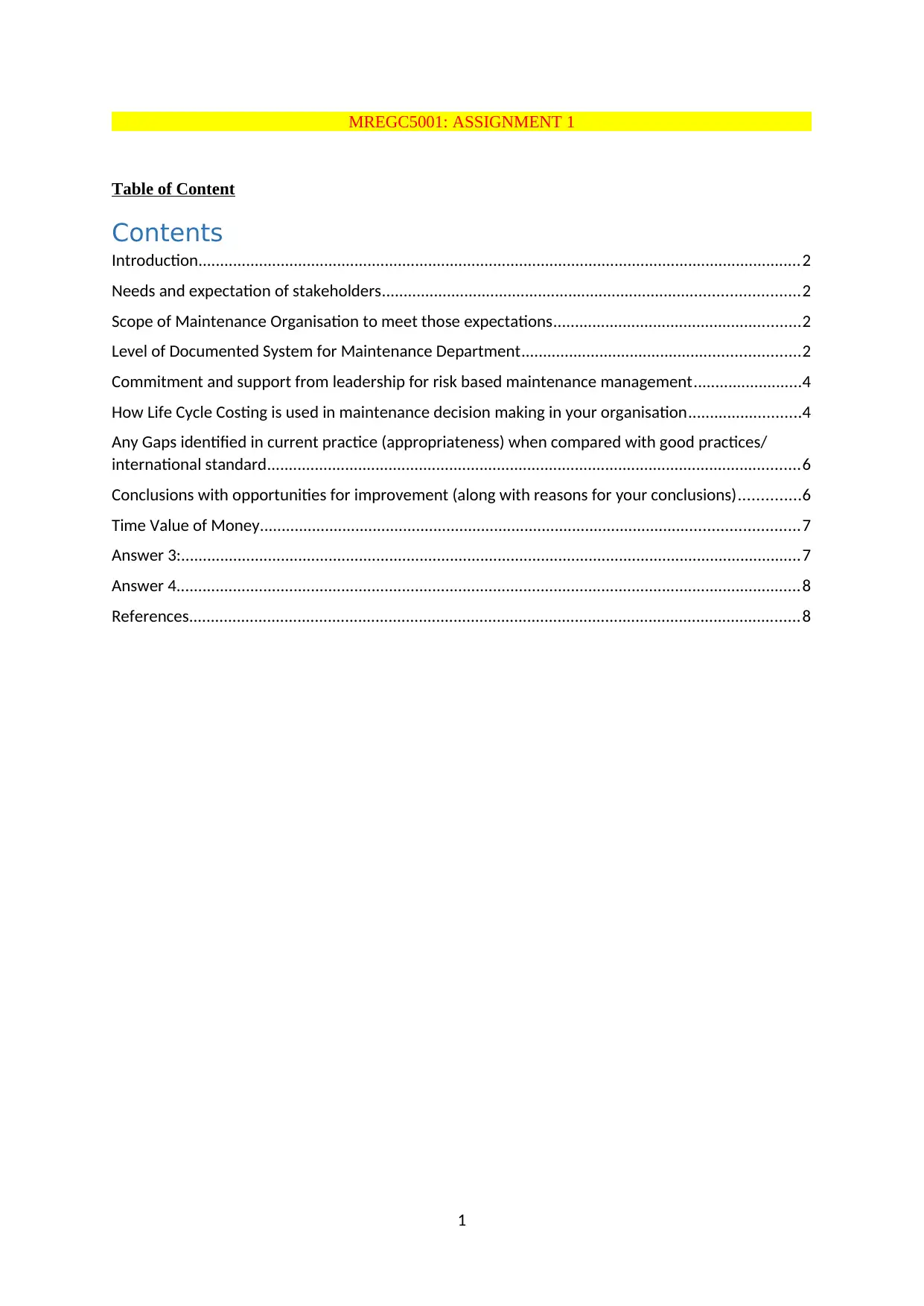
MREGC5001: ASSIGNMENT 1
Table of Content
Contents
Introduction...........................................................................................................................................2
Needs and expectation of stakeholders................................................................................................2
Scope of Maintenance Organisation to meet those expectations.........................................................2
Level of Documented System for Maintenance Department................................................................2
Commitment and support from leadership for risk based maintenance management.........................4
How Life Cycle Costing is used in maintenance decision making in your organisation..........................4
Any Gaps identified in current practice (appropriateness) when compared with good practices/
international standard...........................................................................................................................6
Conclusions with opportunities for improvement (along with reasons for your conclusions)..............6
Time Value of Money............................................................................................................................7
Answer 3:...............................................................................................................................................7
Answer 4................................................................................................................................................8
References.............................................................................................................................................8
1
Table of Content
Contents
Introduction...........................................................................................................................................2
Needs and expectation of stakeholders................................................................................................2
Scope of Maintenance Organisation to meet those expectations.........................................................2
Level of Documented System for Maintenance Department................................................................2
Commitment and support from leadership for risk based maintenance management.........................4
How Life Cycle Costing is used in maintenance decision making in your organisation..........................4
Any Gaps identified in current practice (appropriateness) when compared with good practices/
international standard...........................................................................................................................6
Conclusions with opportunities for improvement (along with reasons for your conclusions)..............6
Time Value of Money............................................................................................................................7
Answer 3:...............................................................................................................................................7
Answer 4................................................................................................................................................8
References.............................................................................................................................................8
1
Paraphrase This Document
Need a fresh take? Get an instant paraphrase of this document with our AI Paraphraser
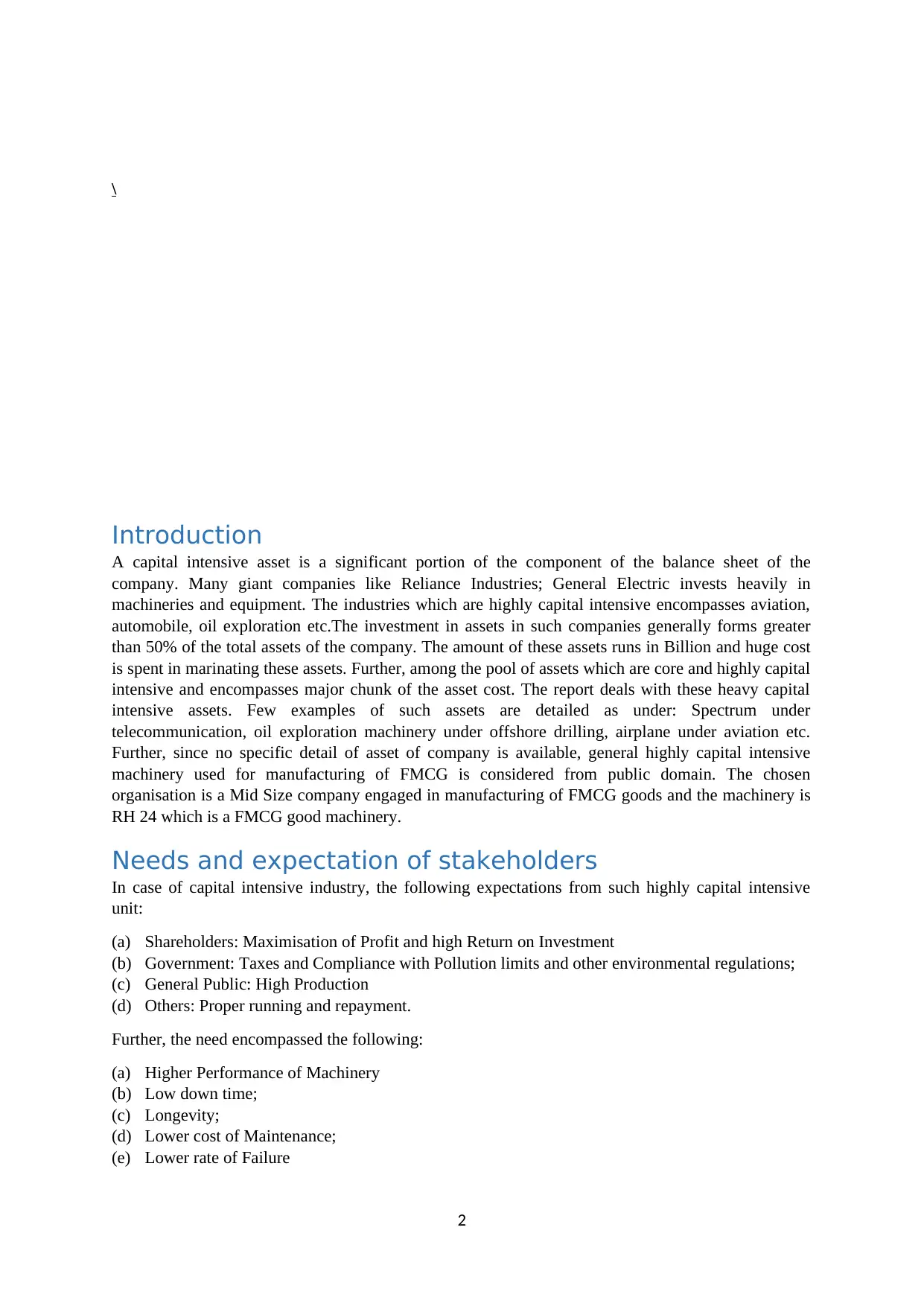
\
Introduction
A capital intensive asset is a significant portion of the component of the balance sheet of the
company. Many giant companies like Reliance Industries; General Electric invests heavily in
machineries and equipment. The industries which are highly capital intensive encompasses aviation,
automobile, oil exploration etc.The investment in assets in such companies generally forms greater
than 50% of the total assets of the company. The amount of these assets runs in Billion and huge cost
is spent in marinating these assets. Further, among the pool of assets which are core and highly capital
intensive and encompasses major chunk of the asset cost. The report deals with these heavy capital
intensive assets. Few examples of such assets are detailed as under: Spectrum under
telecommunication, oil exploration machinery under offshore drilling, airplane under aviation etc.
Further, since no specific detail of asset of company is available, general highly capital intensive
machinery used for manufacturing of FMCG is considered from public domain. The chosen
organisation is a Mid Size company engaged in manufacturing of FMCG goods and the machinery is
RH 24 which is a FMCG good machinery.
Needs and expectation of stakeholders
In case of capital intensive industry, the following expectations from such highly capital intensive
unit:
(a) Shareholders: Maximisation of Profit and high Return on Investment
(b) Government: Taxes and Compliance with Pollution limits and other environmental regulations;
(c) General Public: High Production
(d) Others: Proper running and repayment.
Further, the need encompassed the following:
(a) Higher Performance of Machinery
(b) Low down time;
(c) Longevity;
(d) Lower cost of Maintenance;
(e) Lower rate of Failure
2
Introduction
A capital intensive asset is a significant portion of the component of the balance sheet of the
company. Many giant companies like Reliance Industries; General Electric invests heavily in
machineries and equipment. The industries which are highly capital intensive encompasses aviation,
automobile, oil exploration etc.The investment in assets in such companies generally forms greater
than 50% of the total assets of the company. The amount of these assets runs in Billion and huge cost
is spent in marinating these assets. Further, among the pool of assets which are core and highly capital
intensive and encompasses major chunk of the asset cost. The report deals with these heavy capital
intensive assets. Few examples of such assets are detailed as under: Spectrum under
telecommunication, oil exploration machinery under offshore drilling, airplane under aviation etc.
Further, since no specific detail of asset of company is available, general highly capital intensive
machinery used for manufacturing of FMCG is considered from public domain. The chosen
organisation is a Mid Size company engaged in manufacturing of FMCG goods and the machinery is
RH 24 which is a FMCG good machinery.
Needs and expectation of stakeholders
In case of capital intensive industry, the following expectations from such highly capital intensive
unit:
(a) Shareholders: Maximisation of Profit and high Return on Investment
(b) Government: Taxes and Compliance with Pollution limits and other environmental regulations;
(c) General Public: High Production
(d) Others: Proper running and repayment.
Further, the need encompassed the following:
(a) Higher Performance of Machinery
(b) Low down time;
(c) Longevity;
(d) Lower cost of Maintenance;
(e) Lower rate of Failure
2
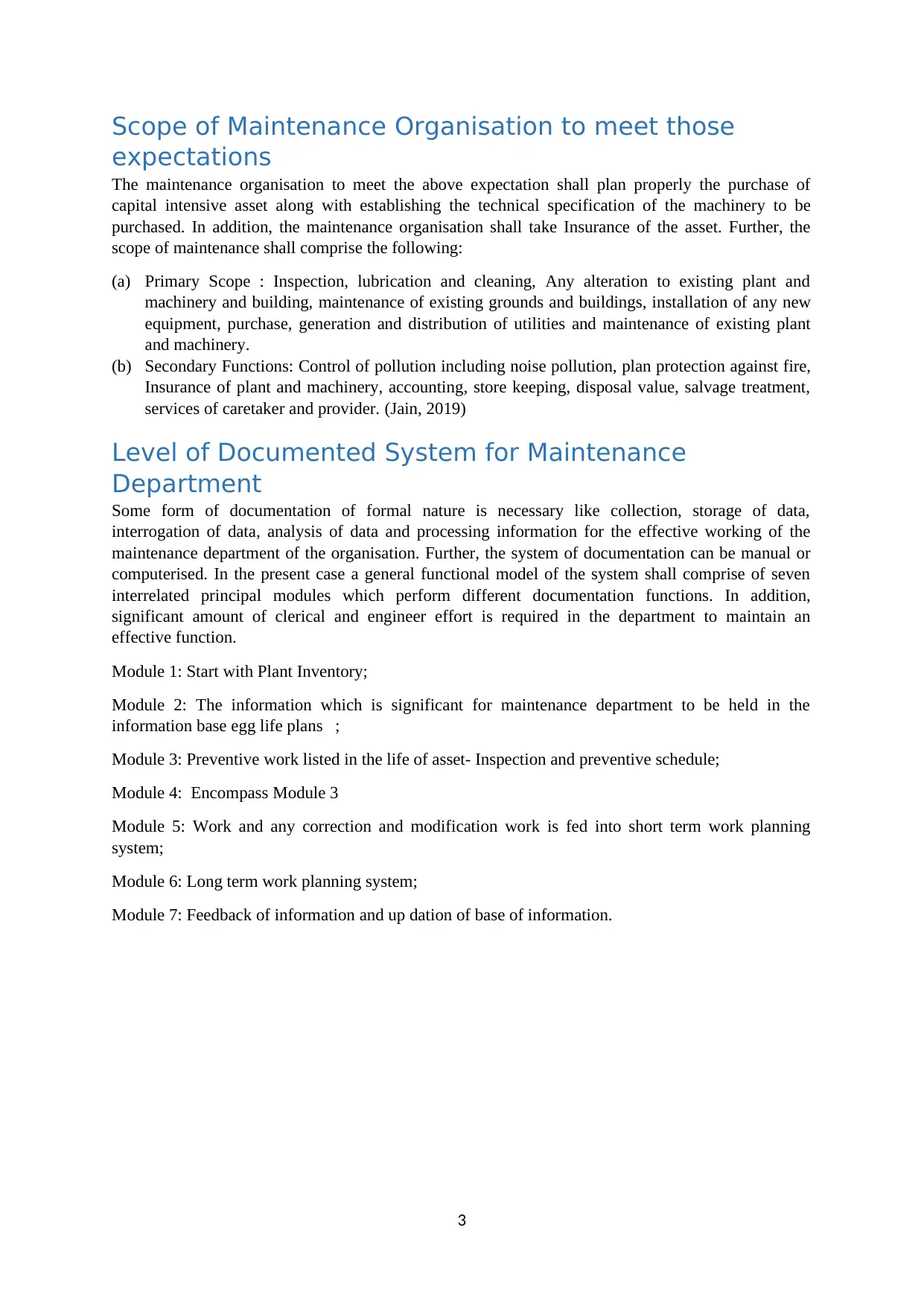
Scope of Maintenance Organisation to meet those
expectations
The maintenance organisation to meet the above expectation shall plan properly the purchase of
capital intensive asset along with establishing the technical specification of the machinery to be
purchased. In addition, the maintenance organisation shall take Insurance of the asset. Further, the
scope of maintenance shall comprise the following:
(a) Primary Scope : Inspection, lubrication and cleaning, Any alteration to existing plant and
machinery and building, maintenance of existing grounds and buildings, installation of any new
equipment, purchase, generation and distribution of utilities and maintenance of existing plant
and machinery.
(b) Secondary Functions: Control of pollution including noise pollution, plan protection against fire,
Insurance of plant and machinery, accounting, store keeping, disposal value, salvage treatment,
services of caretaker and provider. (Jain, 2019)
Level of Documented System for Maintenance
Department
Some form of documentation of formal nature is necessary like collection, storage of data,
interrogation of data, analysis of data and processing information for the effective working of the
maintenance department of the organisation. Further, the system of documentation can be manual or
computerised. In the present case a general functional model of the system shall comprise of seven
interrelated principal modules which perform different documentation functions. In addition,
significant amount of clerical and engineer effort is required in the department to maintain an
effective function.
Module 1: Start with Plant Inventory;
Module 2: The information which is significant for maintenance department to be held in the
information base egg life plans ;
Module 3: Preventive work listed in the life of asset- Inspection and preventive schedule;
Module 4: Encompass Module 3
Module 5: Work and any correction and modification work is fed into short term work planning
system;
Module 6: Long term work planning system;
Module 7: Feedback of information and up dation of base of information.
3
expectations
The maintenance organisation to meet the above expectation shall plan properly the purchase of
capital intensive asset along with establishing the technical specification of the machinery to be
purchased. In addition, the maintenance organisation shall take Insurance of the asset. Further, the
scope of maintenance shall comprise the following:
(a) Primary Scope : Inspection, lubrication and cleaning, Any alteration to existing plant and
machinery and building, maintenance of existing grounds and buildings, installation of any new
equipment, purchase, generation and distribution of utilities and maintenance of existing plant
and machinery.
(b) Secondary Functions: Control of pollution including noise pollution, plan protection against fire,
Insurance of plant and machinery, accounting, store keeping, disposal value, salvage treatment,
services of caretaker and provider. (Jain, 2019)
Level of Documented System for Maintenance
Department
Some form of documentation of formal nature is necessary like collection, storage of data,
interrogation of data, analysis of data and processing information for the effective working of the
maintenance department of the organisation. Further, the system of documentation can be manual or
computerised. In the present case a general functional model of the system shall comprise of seven
interrelated principal modules which perform different documentation functions. In addition,
significant amount of clerical and engineer effort is required in the department to maintain an
effective function.
Module 1: Start with Plant Inventory;
Module 2: The information which is significant for maintenance department to be held in the
information base egg life plans ;
Module 3: Preventive work listed in the life of asset- Inspection and preventive schedule;
Module 4: Encompass Module 3
Module 5: Work and any correction and modification work is fed into short term work planning
system;
Module 6: Long term work planning system;
Module 7: Feedback of information and up dation of base of information.
3
⊘ This is a preview!⊘
Do you want full access?
Subscribe today to unlock all pages.

Trusted by 1+ million students worldwide
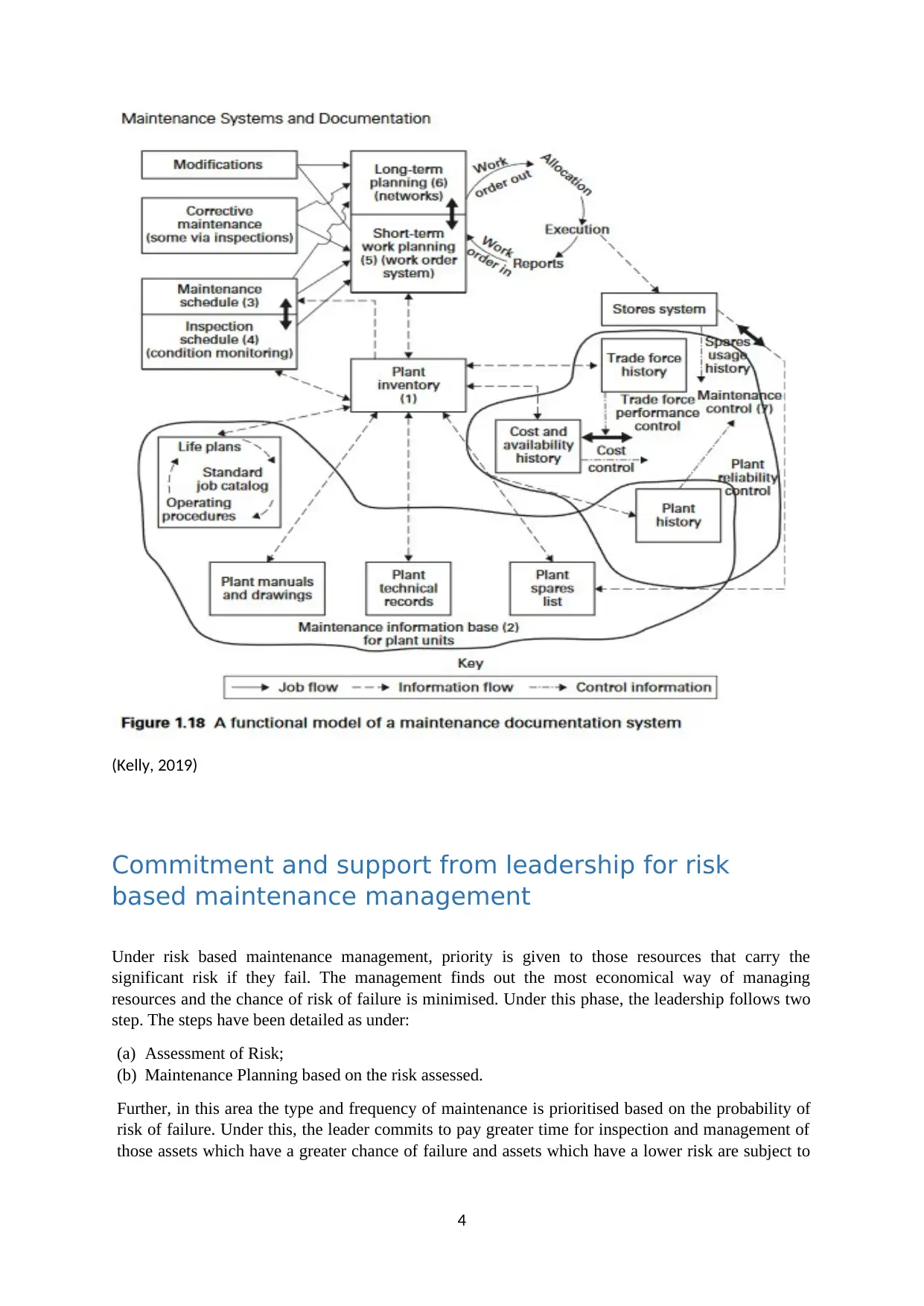
(Kelly, 2019)
Commitment and support from leadership for risk
based maintenance management
Under risk based maintenance management, priority is given to those resources that carry the
significant risk if they fail. The management finds out the most economical way of managing
resources and the chance of risk of failure is minimised. Under this phase, the leadership follows two
step. The steps have been detailed as under:
(a) Assessment of Risk;
(b) Maintenance Planning based on the risk assessed.
Further, in this area the type and frequency of maintenance is prioritised based on the probability of
risk of failure. Under this, the leader commits to pay greater time for inspection and management of
those assets which have a greater chance of failure and assets which have a lower risk are subject to
4
Commitment and support from leadership for risk
based maintenance management
Under risk based maintenance management, priority is given to those resources that carry the
significant risk if they fail. The management finds out the most economical way of managing
resources and the chance of risk of failure is minimised. Under this phase, the leadership follows two
step. The steps have been detailed as under:
(a) Assessment of Risk;
(b) Maintenance Planning based on the risk assessed.
Further, in this area the type and frequency of maintenance is prioritised based on the probability of
risk of failure. Under this, the leader commits to pay greater time for inspection and management of
those assets which have a greater chance of failure and assets which have a lower risk are subject to
4
Paraphrase This Document
Need a fresh take? Get an instant paraphrase of this document with our AI Paraphraser
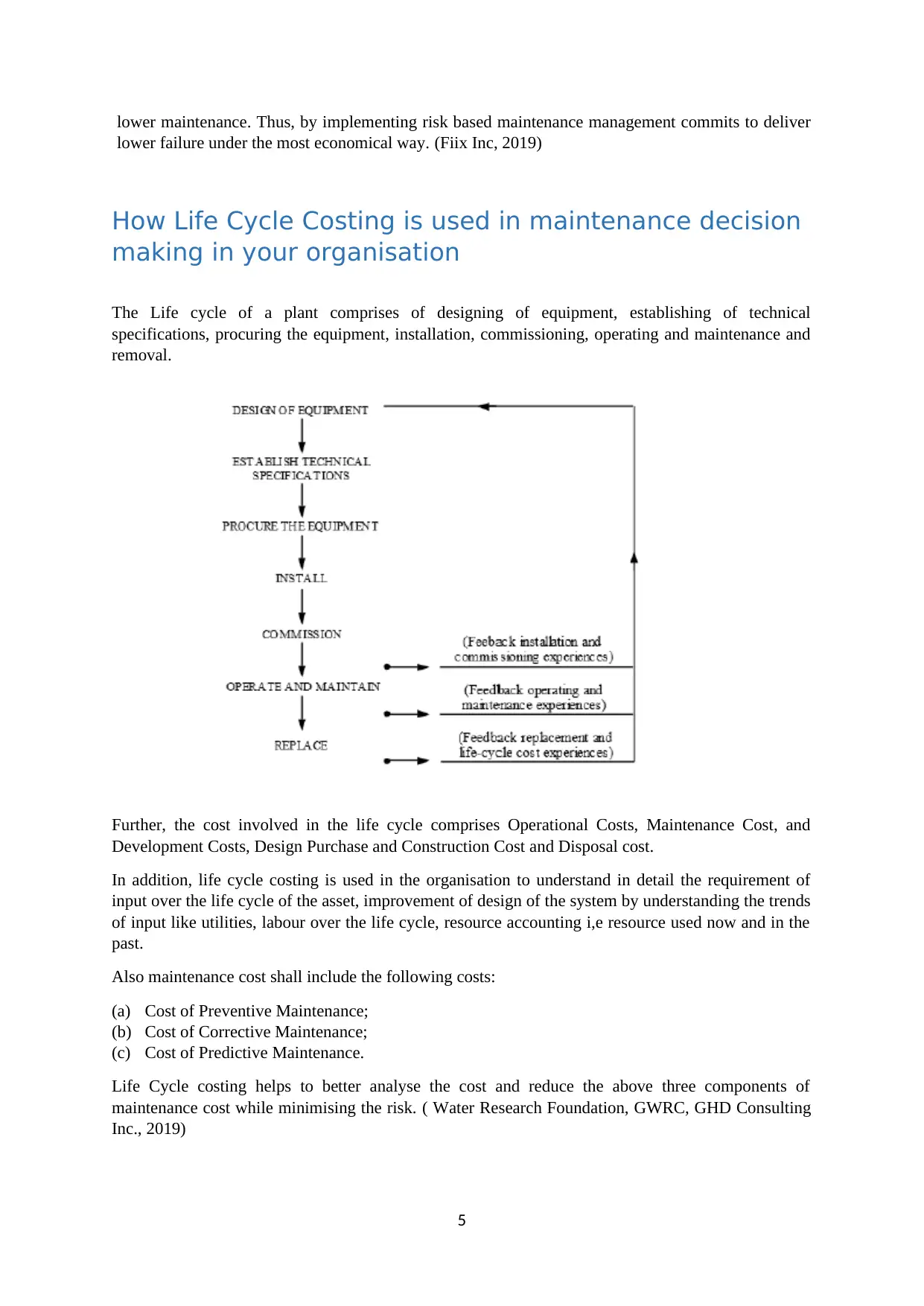
lower maintenance. Thus, by implementing risk based maintenance management commits to deliver
lower failure under the most economical way. (Fiix Inc, 2019)
How Life Cycle Costing is used in maintenance decision
making in your organisation
The Life cycle of a plant comprises of designing of equipment, establishing of technical
specifications, procuring the equipment, installation, commissioning, operating and maintenance and
removal.
Further, the cost involved in the life cycle comprises Operational Costs, Maintenance Cost, and
Development Costs, Design Purchase and Construction Cost and Disposal cost.
In addition, life cycle costing is used in the organisation to understand in detail the requirement of
input over the life cycle of the asset, improvement of design of the system by understanding the trends
of input like utilities, labour over the life cycle, resource accounting i,e resource used now and in the
past.
Also maintenance cost shall include the following costs:
(a) Cost of Preventive Maintenance;
(b) Cost of Corrective Maintenance;
(c) Cost of Predictive Maintenance.
Life Cycle costing helps to better analyse the cost and reduce the above three components of
maintenance cost while minimising the risk. ( Water Research Foundation, GWRC, GHD Consulting
Inc., 2019)
5
lower failure under the most economical way. (Fiix Inc, 2019)
How Life Cycle Costing is used in maintenance decision
making in your organisation
The Life cycle of a plant comprises of designing of equipment, establishing of technical
specifications, procuring the equipment, installation, commissioning, operating and maintenance and
removal.
Further, the cost involved in the life cycle comprises Operational Costs, Maintenance Cost, and
Development Costs, Design Purchase and Construction Cost and Disposal cost.
In addition, life cycle costing is used in the organisation to understand in detail the requirement of
input over the life cycle of the asset, improvement of design of the system by understanding the trends
of input like utilities, labour over the life cycle, resource accounting i,e resource used now and in the
past.
Also maintenance cost shall include the following costs:
(a) Cost of Preventive Maintenance;
(b) Cost of Corrective Maintenance;
(c) Cost of Predictive Maintenance.
Life Cycle costing helps to better analyse the cost and reduce the above three components of
maintenance cost while minimising the risk. ( Water Research Foundation, GWRC, GHD Consulting
Inc., 2019)
5
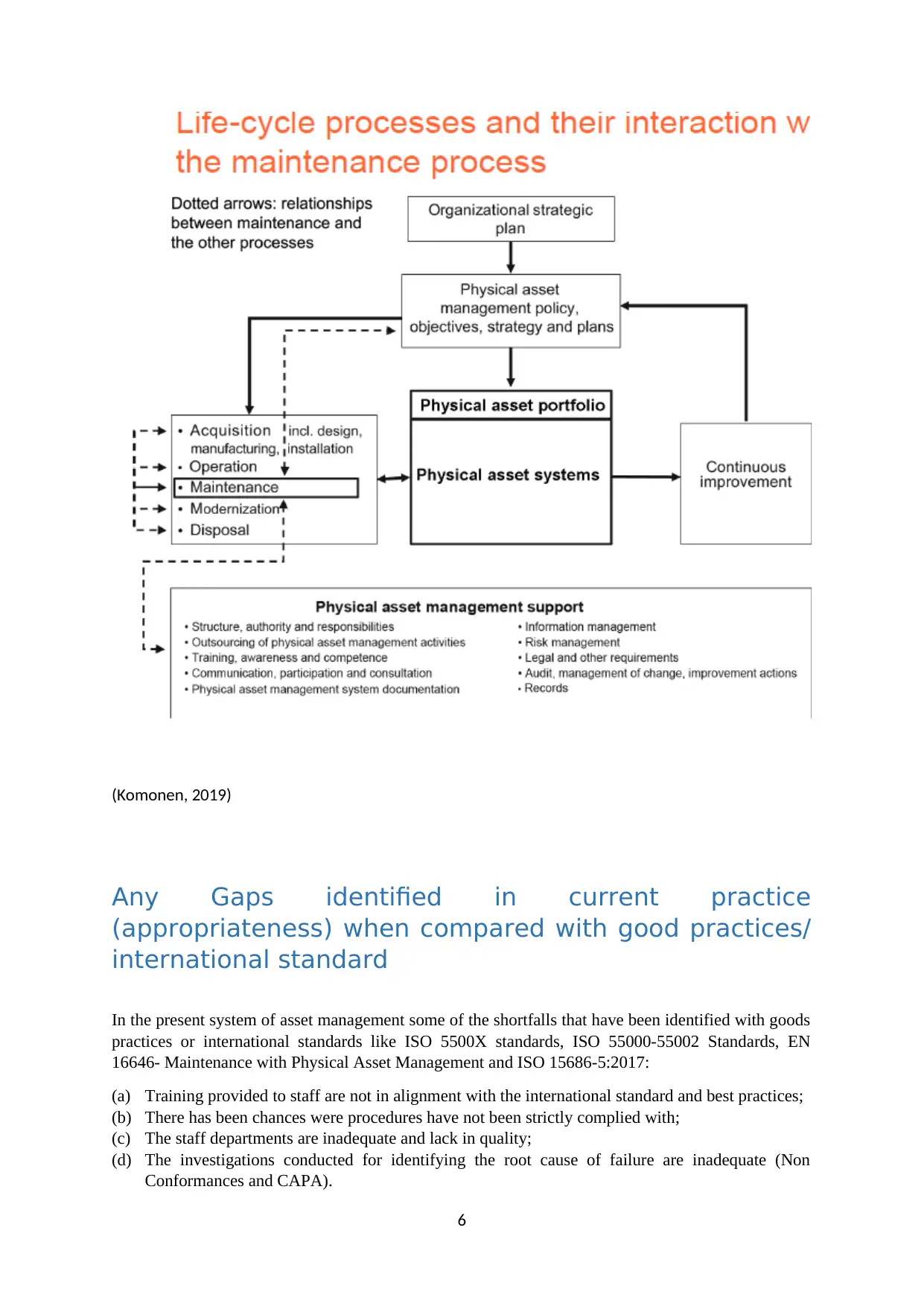
(Komonen, 2019)
Any Gaps identified in current practice
(appropriateness) when compared with good practices/
international standard
In the present system of asset management some of the shortfalls that have been identified with goods
practices or international standards like ISO 5500X standards, ISO 55000-55002 Standards, EN
16646- Maintenance with Physical Asset Management and ISO 15686-5:2017:
(a) Training provided to staff are not in alignment with the international standard and best practices;
(b) There has been chances were procedures have not been strictly complied with;
(c) The staff departments are inadequate and lack in quality;
(d) The investigations conducted for identifying the root cause of failure are inadequate (Non
Conformances and CAPA).
6
Any Gaps identified in current practice
(appropriateness) when compared with good practices/
international standard
In the present system of asset management some of the shortfalls that have been identified with goods
practices or international standards like ISO 5500X standards, ISO 55000-55002 Standards, EN
16646- Maintenance with Physical Asset Management and ISO 15686-5:2017:
(a) Training provided to staff are not in alignment with the international standard and best practices;
(b) There has been chances were procedures have not been strictly complied with;
(c) The staff departments are inadequate and lack in quality;
(d) The investigations conducted for identifying the root cause of failure are inadequate (Non
Conformances and CAPA).
6
⊘ This is a preview!⊘
Do you want full access?
Subscribe today to unlock all pages.

Trusted by 1+ million students worldwide
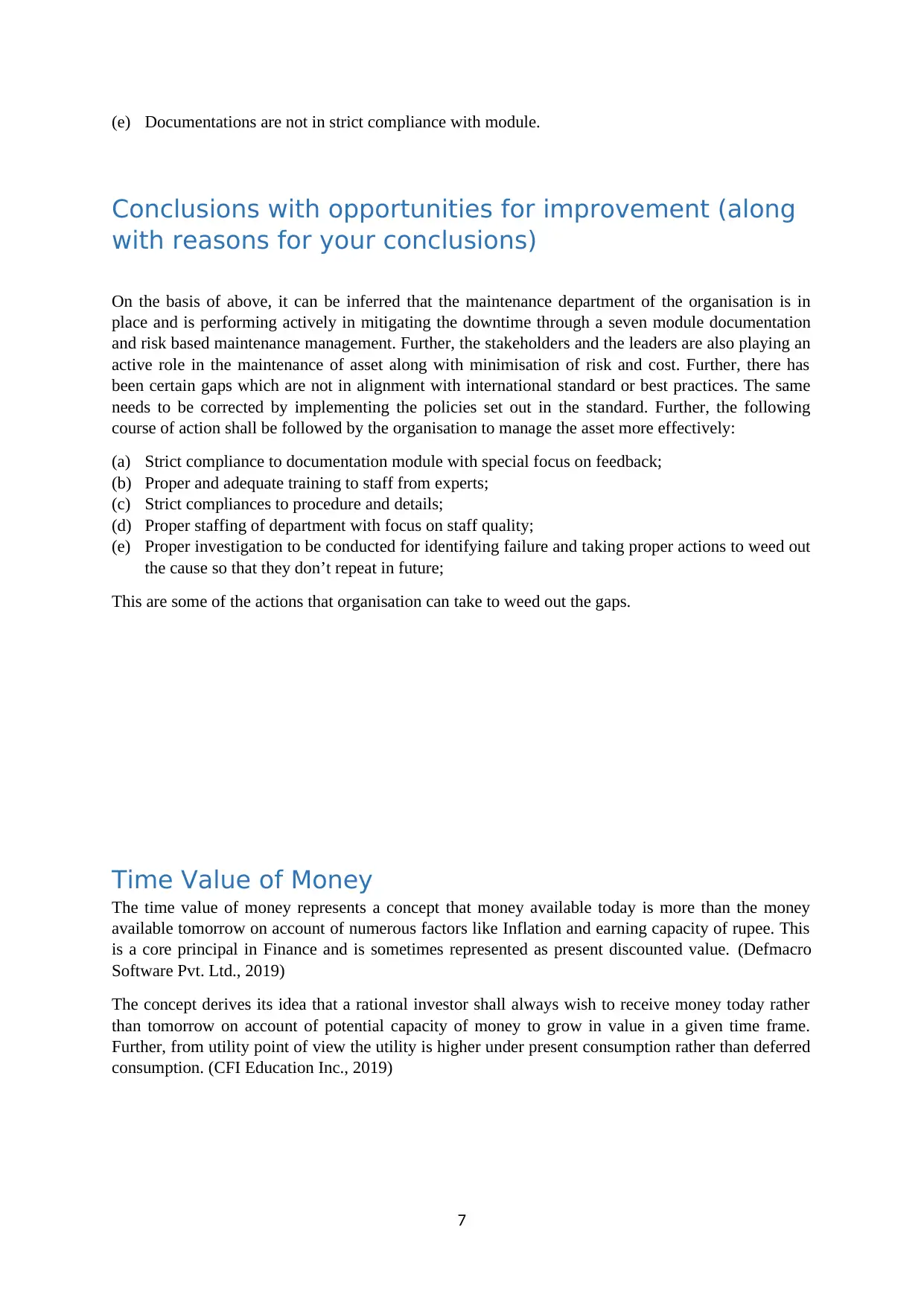
(e) Documentations are not in strict compliance with module.
Conclusions with opportunities for improvement (along
with reasons for your conclusions)
On the basis of above, it can be inferred that the maintenance department of the organisation is in
place and is performing actively in mitigating the downtime through a seven module documentation
and risk based maintenance management. Further, the stakeholders and the leaders are also playing an
active role in the maintenance of asset along with minimisation of risk and cost. Further, there has
been certain gaps which are not in alignment with international standard or best practices. The same
needs to be corrected by implementing the policies set out in the standard. Further, the following
course of action shall be followed by the organisation to manage the asset more effectively:
(a) Strict compliance to documentation module with special focus on feedback;
(b) Proper and adequate training to staff from experts;
(c) Strict compliances to procedure and details;
(d) Proper staffing of department with focus on staff quality;
(e) Proper investigation to be conducted for identifying failure and taking proper actions to weed out
the cause so that they don’t repeat in future;
This are some of the actions that organisation can take to weed out the gaps.
Time Value of Money
The time value of money represents a concept that money available today is more than the money
available tomorrow on account of numerous factors like Inflation and earning capacity of rupee. This
is a core principal in Finance and is sometimes represented as present discounted value. (Defmacro
Software Pvt. Ltd., 2019)
The concept derives its idea that a rational investor shall always wish to receive money today rather
than tomorrow on account of potential capacity of money to grow in value in a given time frame.
Further, from utility point of view the utility is higher under present consumption rather than deferred
consumption. (CFI Education Inc., 2019)
7
Conclusions with opportunities for improvement (along
with reasons for your conclusions)
On the basis of above, it can be inferred that the maintenance department of the organisation is in
place and is performing actively in mitigating the downtime through a seven module documentation
and risk based maintenance management. Further, the stakeholders and the leaders are also playing an
active role in the maintenance of asset along with minimisation of risk and cost. Further, there has
been certain gaps which are not in alignment with international standard or best practices. The same
needs to be corrected by implementing the policies set out in the standard. Further, the following
course of action shall be followed by the organisation to manage the asset more effectively:
(a) Strict compliance to documentation module with special focus on feedback;
(b) Proper and adequate training to staff from experts;
(c) Strict compliances to procedure and details;
(d) Proper staffing of department with focus on staff quality;
(e) Proper investigation to be conducted for identifying failure and taking proper actions to weed out
the cause so that they don’t repeat in future;
This are some of the actions that organisation can take to weed out the gaps.
Time Value of Money
The time value of money represents a concept that money available today is more than the money
available tomorrow on account of numerous factors like Inflation and earning capacity of rupee. This
is a core principal in Finance and is sometimes represented as present discounted value. (Defmacro
Software Pvt. Ltd., 2019)
The concept derives its idea that a rational investor shall always wish to receive money today rather
than tomorrow on account of potential capacity of money to grow in value in a given time frame.
Further, from utility point of view the utility is higher under present consumption rather than deferred
consumption. (CFI Education Inc., 2019)
7
Paraphrase This Document
Need a fresh take? Get an instant paraphrase of this document with our AI Paraphraser
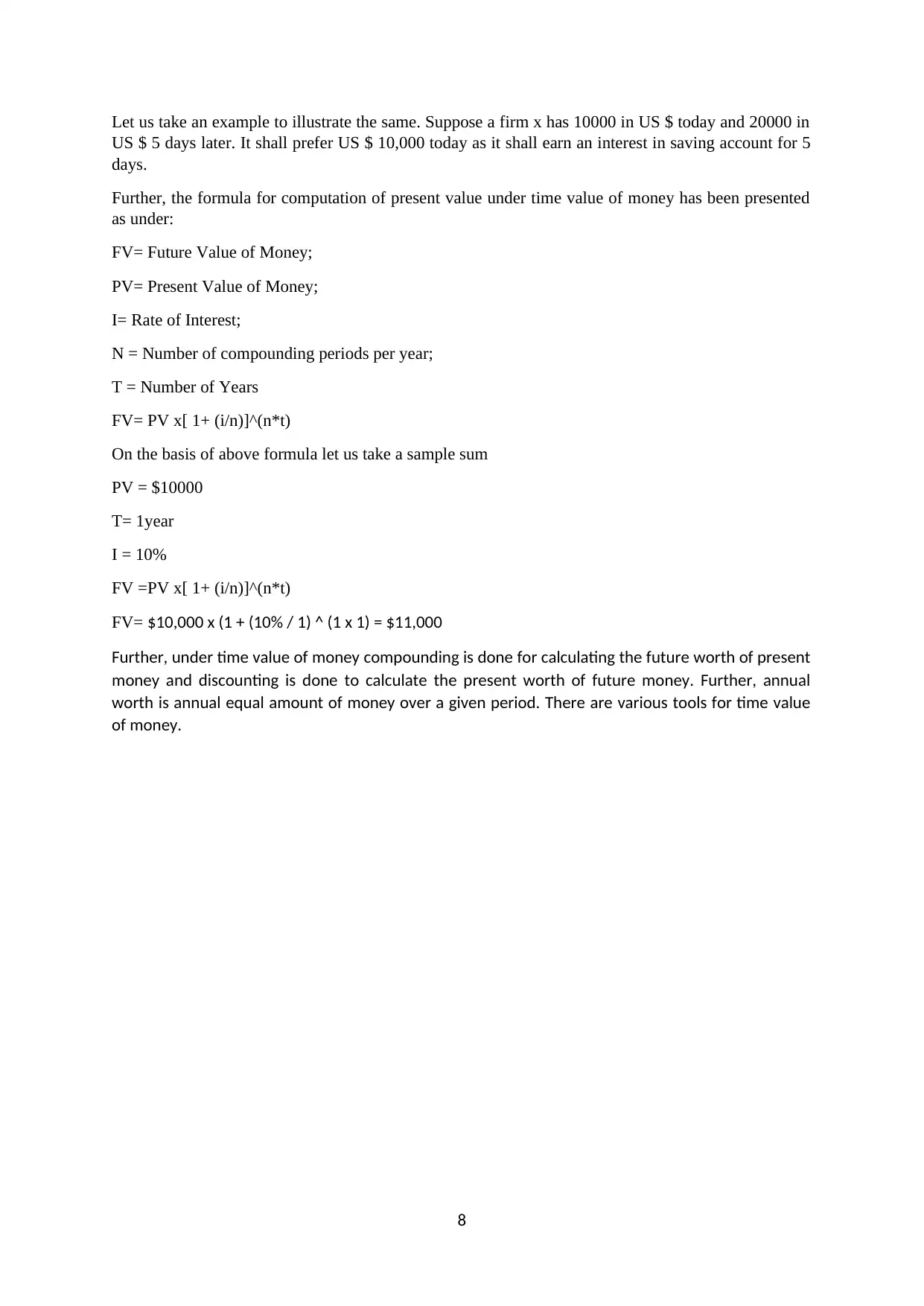
Let us take an example to illustrate the same. Suppose a firm x has 10000 in US $ today and 20000 in
US $ 5 days later. It shall prefer US $ 10,000 today as it shall earn an interest in saving account for 5
days.
Further, the formula for computation of present value under time value of money has been presented
as under:
FV= Future Value of Money;
PV= Present Value of Money;
I= Rate of Interest;
N = Number of compounding periods per year;
T = Number of Years
FV= PV x[ 1+ (i/n)]^(n*t)
On the basis of above formula let us take a sample sum
PV = $10000
T= 1year
I = 10%
FV =PV x[ 1+ (i/n)]^(n*t)
FV= $10,000 x (1 + (10% / 1) ^ (1 x 1) = $11,000
Further, under time value of money compounding is done for calculating the future worth of present
money and discounting is done to calculate the present worth of future money. Further, annual
worth is annual equal amount of money over a given period. There are various tools for time value
of money.
8
US $ 5 days later. It shall prefer US $ 10,000 today as it shall earn an interest in saving account for 5
days.
Further, the formula for computation of present value under time value of money has been presented
as under:
FV= Future Value of Money;
PV= Present Value of Money;
I= Rate of Interest;
N = Number of compounding periods per year;
T = Number of Years
FV= PV x[ 1+ (i/n)]^(n*t)
On the basis of above formula let us take a sample sum
PV = $10000
T= 1year
I = 10%
FV =PV x[ 1+ (i/n)]^(n*t)
FV= $10,000 x (1 + (10% / 1) ^ (1 x 1) = $11,000
Further, under time value of money compounding is done for calculating the future worth of present
money and discounting is done to calculate the present worth of future money. Further, annual
worth is annual equal amount of money over a given period. There are various tools for time value
of money.
8
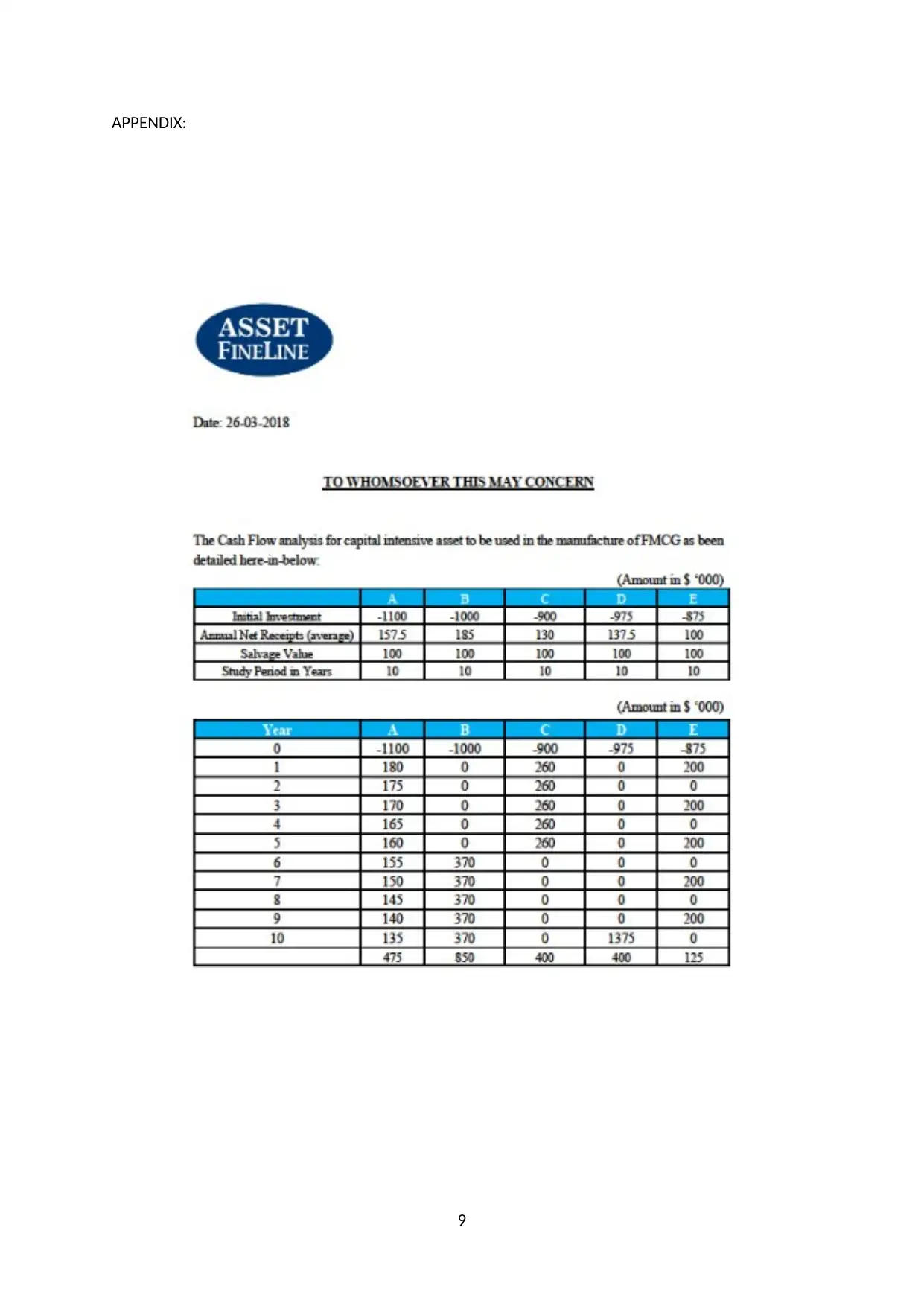
APPENDIX:
9
9
⊘ This is a preview!⊘
Do you want full access?
Subscribe today to unlock all pages.

Trusted by 1+ million students worldwide
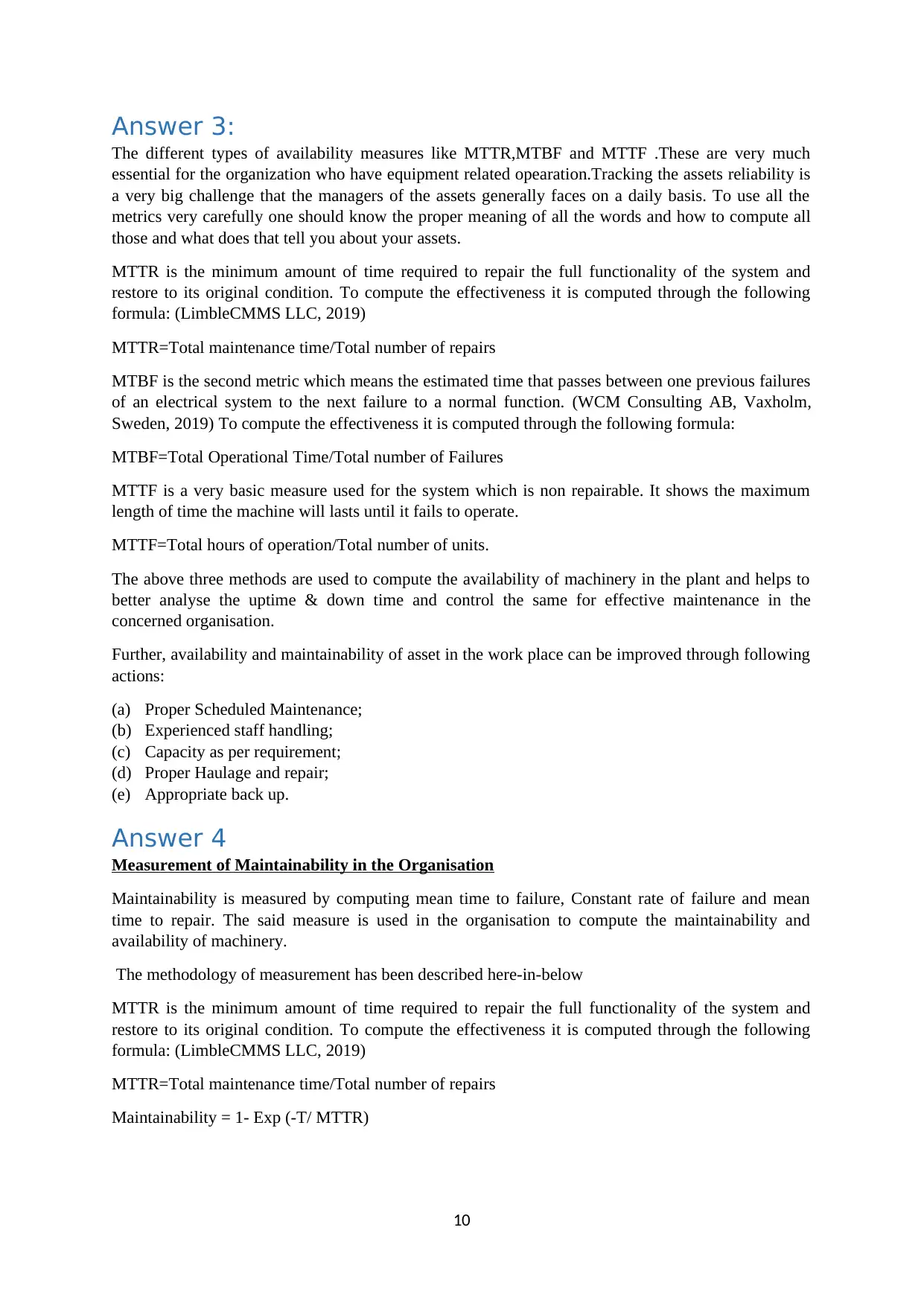
Answer 3:
The different types of availability measures like MTTR,MTBF and MTTF .These are very much
essential for the organization who have equipment related opearation.Tracking the assets reliability is
a very big challenge that the managers of the assets generally faces on a daily basis. To use all the
metrics very carefully one should know the proper meaning of all the words and how to compute all
those and what does that tell you about your assets.
MTTR is the minimum amount of time required to repair the full functionality of the system and
restore to its original condition. To compute the effectiveness it is computed through the following
formula: (LimbleCMMS LLC, 2019)
MTTR=Total maintenance time/Total number of repairs
MTBF is the second metric which means the estimated time that passes between one previous failures
of an electrical system to the next failure to a normal function. (WCM Consulting AB, Vaxholm,
Sweden, 2019) To compute the effectiveness it is computed through the following formula:
MTBF=Total Operational Time/Total number of Failures
MTTF is a very basic measure used for the system which is non repairable. It shows the maximum
length of time the machine will lasts until it fails to operate.
MTTF=Total hours of operation/Total number of units.
The above three methods are used to compute the availability of machinery in the plant and helps to
better analyse the uptime & down time and control the same for effective maintenance in the
concerned organisation.
Further, availability and maintainability of asset in the work place can be improved through following
actions:
(a) Proper Scheduled Maintenance;
(b) Experienced staff handling;
(c) Capacity as per requirement;
(d) Proper Haulage and repair;
(e) Appropriate back up.
Answer 4
Measurement of Maintainability in the Organisation
Maintainability is measured by computing mean time to failure, Constant rate of failure and mean
time to repair. The said measure is used in the organisation to compute the maintainability and
availability of machinery.
The methodology of measurement has been described here-in-below
MTTR is the minimum amount of time required to repair the full functionality of the system and
restore to its original condition. To compute the effectiveness it is computed through the following
formula: (LimbleCMMS LLC, 2019)
MTTR=Total maintenance time/Total number of repairs
Maintainability = 1- Exp (-T/ MTTR)
10
The different types of availability measures like MTTR,MTBF and MTTF .These are very much
essential for the organization who have equipment related opearation.Tracking the assets reliability is
a very big challenge that the managers of the assets generally faces on a daily basis. To use all the
metrics very carefully one should know the proper meaning of all the words and how to compute all
those and what does that tell you about your assets.
MTTR is the minimum amount of time required to repair the full functionality of the system and
restore to its original condition. To compute the effectiveness it is computed through the following
formula: (LimbleCMMS LLC, 2019)
MTTR=Total maintenance time/Total number of repairs
MTBF is the second metric which means the estimated time that passes between one previous failures
of an electrical system to the next failure to a normal function. (WCM Consulting AB, Vaxholm,
Sweden, 2019) To compute the effectiveness it is computed through the following formula:
MTBF=Total Operational Time/Total number of Failures
MTTF is a very basic measure used for the system which is non repairable. It shows the maximum
length of time the machine will lasts until it fails to operate.
MTTF=Total hours of operation/Total number of units.
The above three methods are used to compute the availability of machinery in the plant and helps to
better analyse the uptime & down time and control the same for effective maintenance in the
concerned organisation.
Further, availability and maintainability of asset in the work place can be improved through following
actions:
(a) Proper Scheduled Maintenance;
(b) Experienced staff handling;
(c) Capacity as per requirement;
(d) Proper Haulage and repair;
(e) Appropriate back up.
Answer 4
Measurement of Maintainability in the Organisation
Maintainability is measured by computing mean time to failure, Constant rate of failure and mean
time to repair. The said measure is used in the organisation to compute the maintainability and
availability of machinery.
The methodology of measurement has been described here-in-below
MTTR is the minimum amount of time required to repair the full functionality of the system and
restore to its original condition. To compute the effectiveness it is computed through the following
formula: (LimbleCMMS LLC, 2019)
MTTR=Total maintenance time/Total number of repairs
Maintainability = 1- Exp (-T/ MTTR)
10
Paraphrase This Document
Need a fresh take? Get an instant paraphrase of this document with our AI Paraphraser
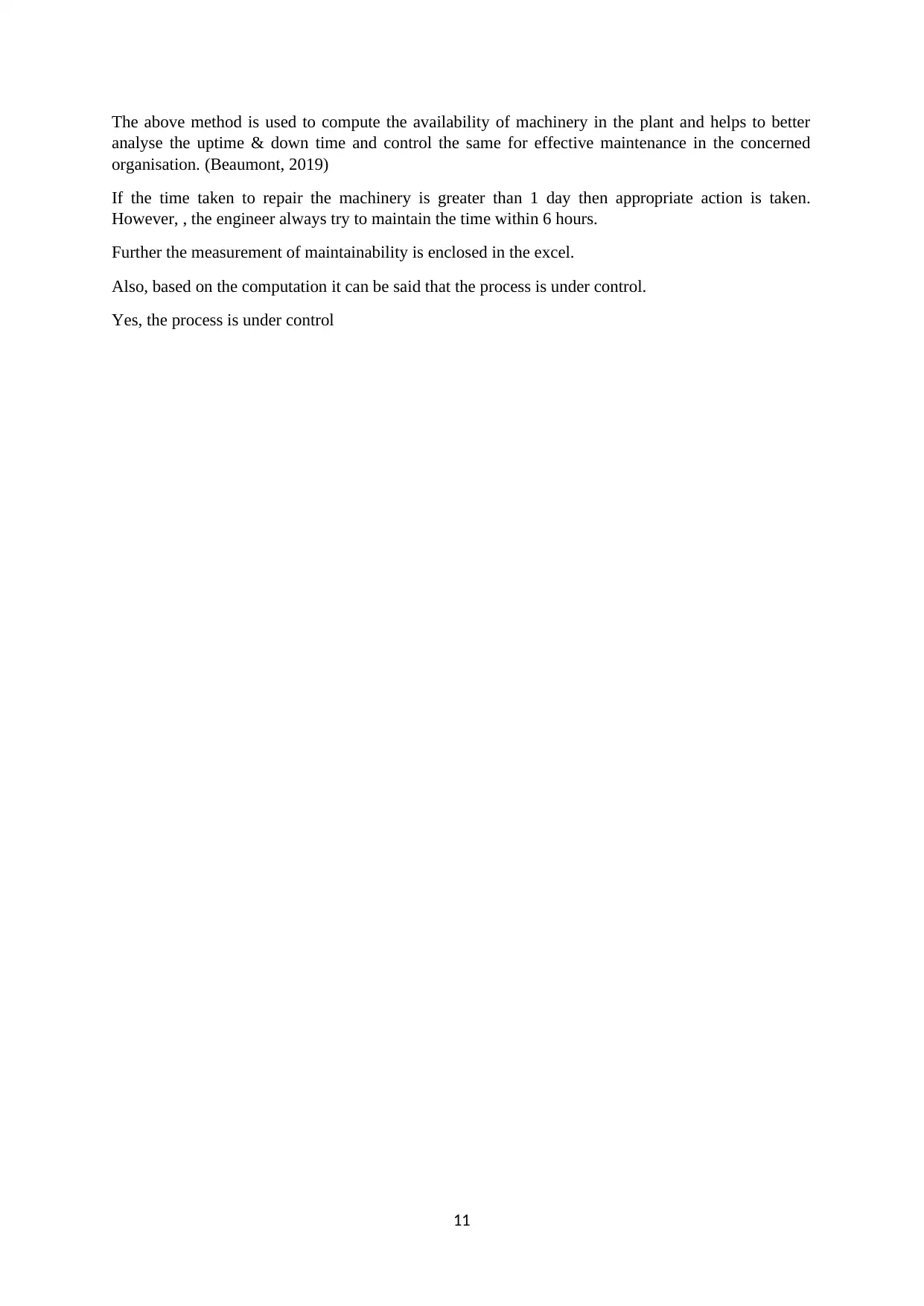
The above method is used to compute the availability of machinery in the plant and helps to better
analyse the uptime & down time and control the same for effective maintenance in the concerned
organisation. (Beaumont, 2019)
If the time taken to repair the machinery is greater than 1 day then appropriate action is taken.
However, , the engineer always try to maintain the time within 6 hours.
Further the measurement of maintainability is enclosed in the excel.
Also, based on the computation it can be said that the process is under control.
Yes, the process is under control
11
analyse the uptime & down time and control the same for effective maintenance in the concerned
organisation. (Beaumont, 2019)
If the time taken to repair the machinery is greater than 1 day then appropriate action is taken.
However, , the engineer always try to maintain the time within 6 hours.
Further the measurement of maintainability is enclosed in the excel.
Also, based on the computation it can be said that the process is under control.
Yes, the process is under control
11
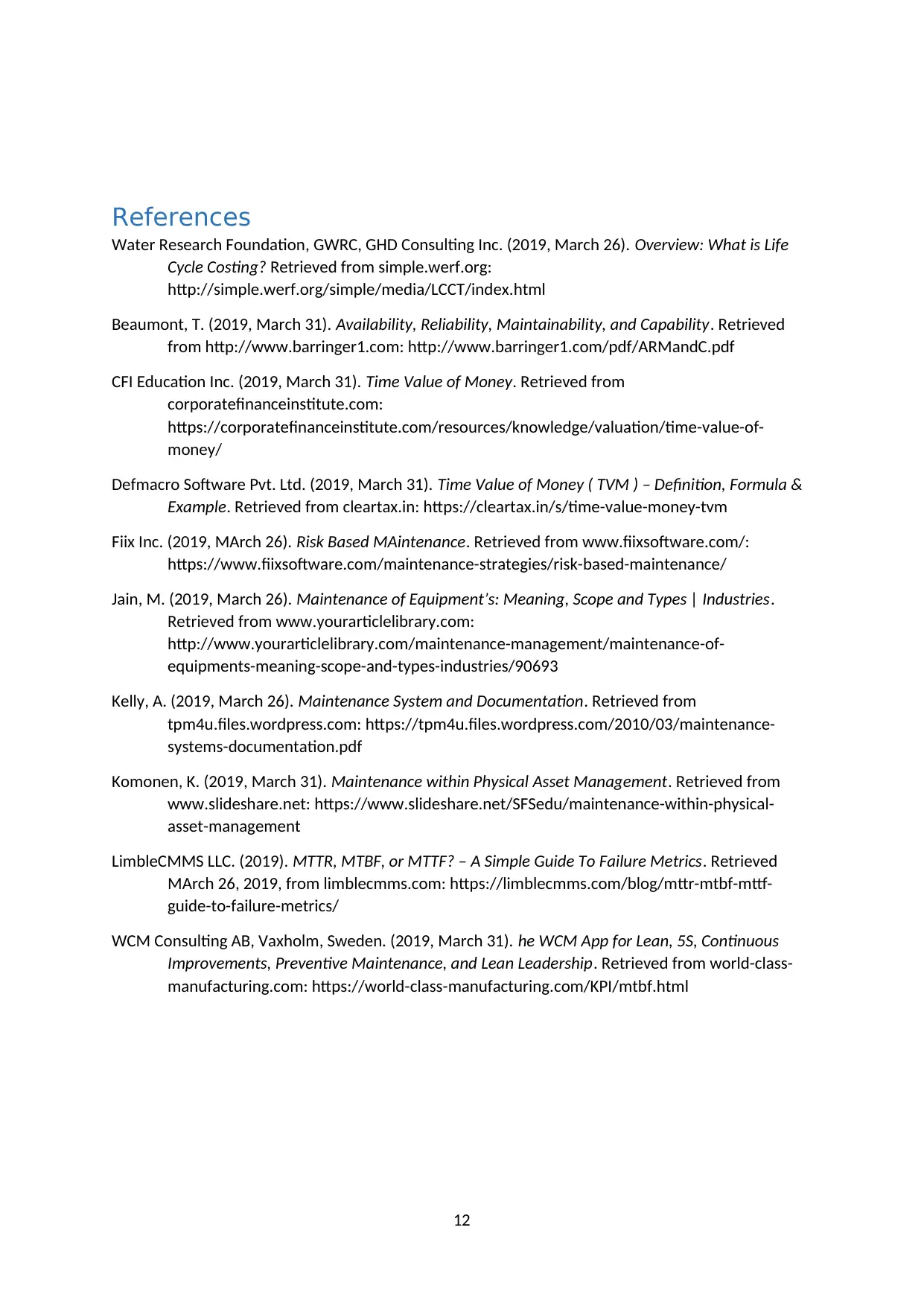
References
Water Research Foundation, GWRC, GHD Consulting Inc. (2019, March 26). Overview: What is Life
Cycle Costing? Retrieved from simple.werf.org:
http://simple.werf.org/simple/media/LCCT/index.html
Beaumont, T. (2019, March 31). Availability, Reliability, Maintainability, and Capability. Retrieved
from http://www.barringer1.com: http://www.barringer1.com/pdf/ARMandC.pdf
CFI Education Inc. (2019, March 31). Time Value of Money. Retrieved from
corporatefinanceinstitute.com:
https://corporatefinanceinstitute.com/resources/knowledge/valuation/time-value-of-
money/
Defmacro Software Pvt. Ltd. (2019, March 31). Time Value of Money ( TVM ) – Definition, Formula &
Example. Retrieved from cleartax.in: https://cleartax.in/s/time-value-money-tvm
Fiix Inc. (2019, MArch 26). Risk Based MAintenance. Retrieved from www.fiixsoftware.com/:
https://www.fiixsoftware.com/maintenance-strategies/risk-based-maintenance/
Jain, M. (2019, March 26). Maintenance of Equipment’s: Meaning, Scope and Types | Industries.
Retrieved from www.yourarticlelibrary.com:
http://www.yourarticlelibrary.com/maintenance-management/maintenance-of-
equipments-meaning-scope-and-types-industries/90693
Kelly, A. (2019, March 26). Maintenance System and Documentation. Retrieved from
tpm4u.files.wordpress.com: https://tpm4u.files.wordpress.com/2010/03/maintenance-
systems-documentation.pdf
Komonen, K. (2019, March 31). Maintenance within Physical Asset Management. Retrieved from
www.slideshare.net: https://www.slideshare.net/SFSedu/maintenance-within-physical-
asset-management
LimbleCMMS LLC. (2019). MTTR, MTBF, or MTTF? – A Simple Guide To Failure Metrics. Retrieved
MArch 26, 2019, from limblecmms.com: https://limblecmms.com/blog/mttr-mtbf-mttf-
guide-to-failure-metrics/
WCM Consulting AB, Vaxholm, Sweden. (2019, March 31). he WCM App for Lean, 5S, Continuous
Improvements, Preventive Maintenance, and Lean Leadership. Retrieved from world-class-
manufacturing.com: https://world-class-manufacturing.com/KPI/mtbf.html
12
Water Research Foundation, GWRC, GHD Consulting Inc. (2019, March 26). Overview: What is Life
Cycle Costing? Retrieved from simple.werf.org:
http://simple.werf.org/simple/media/LCCT/index.html
Beaumont, T. (2019, March 31). Availability, Reliability, Maintainability, and Capability. Retrieved
from http://www.barringer1.com: http://www.barringer1.com/pdf/ARMandC.pdf
CFI Education Inc. (2019, March 31). Time Value of Money. Retrieved from
corporatefinanceinstitute.com:
https://corporatefinanceinstitute.com/resources/knowledge/valuation/time-value-of-
money/
Defmacro Software Pvt. Ltd. (2019, March 31). Time Value of Money ( TVM ) – Definition, Formula &
Example. Retrieved from cleartax.in: https://cleartax.in/s/time-value-money-tvm
Fiix Inc. (2019, MArch 26). Risk Based MAintenance. Retrieved from www.fiixsoftware.com/:
https://www.fiixsoftware.com/maintenance-strategies/risk-based-maintenance/
Jain, M. (2019, March 26). Maintenance of Equipment’s: Meaning, Scope and Types | Industries.
Retrieved from www.yourarticlelibrary.com:
http://www.yourarticlelibrary.com/maintenance-management/maintenance-of-
equipments-meaning-scope-and-types-industries/90693
Kelly, A. (2019, March 26). Maintenance System and Documentation. Retrieved from
tpm4u.files.wordpress.com: https://tpm4u.files.wordpress.com/2010/03/maintenance-
systems-documentation.pdf
Komonen, K. (2019, March 31). Maintenance within Physical Asset Management. Retrieved from
www.slideshare.net: https://www.slideshare.net/SFSedu/maintenance-within-physical-
asset-management
LimbleCMMS LLC. (2019). MTTR, MTBF, or MTTF? – A Simple Guide To Failure Metrics. Retrieved
MArch 26, 2019, from limblecmms.com: https://limblecmms.com/blog/mttr-mtbf-mttf-
guide-to-failure-metrics/
WCM Consulting AB, Vaxholm, Sweden. (2019, March 31). he WCM App for Lean, 5S, Continuous
Improvements, Preventive Maintenance, and Lean Leadership. Retrieved from world-class-
manufacturing.com: https://world-class-manufacturing.com/KPI/mtbf.html
12
⊘ This is a preview!⊘
Do you want full access?
Subscribe today to unlock all pages.

Trusted by 1+ million students worldwide
1 out of 12
Related Documents
Your All-in-One AI-Powered Toolkit for Academic Success.
+13062052269
info@desklib.com
Available 24*7 on WhatsApp / Email
![[object Object]](/_next/static/media/star-bottom.7253800d.svg)
Unlock your academic potential
Copyright © 2020–2025 A2Z Services. All Rights Reserved. Developed and managed by ZUCOL.





